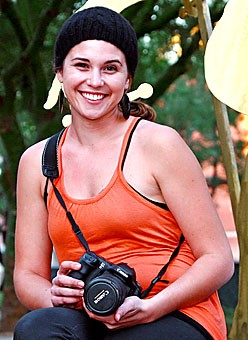Who: Leah Romaniello, 22, photography senior
What: At the beginning of next year, Romaniello will have a show at Shane House Gallery, 218 S. Fourth Ave. It’s called “”The Displacement Series,”” and it consists of domestic items in obscure locations or unnatural settings. An example is a bed and a night stand and a lamp and an alarm clock in a parking lot. The concept of the series involves the lack of or absence of personal space.
Bio: Romaniello lived in Alaska and London as well as the United States, and attended Tucson High School. She decided to focus on photography because she felt like it’s an open door with options, she said. It released her creative spirit.
Wildcat: What inspires you as a photographer?
Romaniello: Being able to manipulate the moment or capture something that’s very specific and altering my reality, altering reality that corresponds to my vision.
W: What do you think makes you a unique artist?
R: My work is oftentimes somewhat surreal. The two projects that I’m working on right now are borderline grotesque and beautiful and surreal and dreamlike. I like to create a juxtaposition between reality and surrealism.
W: What do the pictures look like?
R: The series that I’ve been working on is a self-portrait series, and it’s examining the subconscious. It examines an inner turmoil, a conflict that’s combating a physical and emotional realm. I think a lot of people have a difficult time explaining their work because they’re still working on it. I’ve been working on the series for about a year. A photo that I’ve taken is a figure emerging out of blackness. It’s out of like a nylon fabric and the figure wants to get out of it. It’s like a transparent cocoon, and it has a lot of movement to it. You can see the figure trying to release itself through struggling. It’s a universal conflict, something that everybody goes through. I believe in it personally.
W: Who’s your favorite photographer?
R: Diane Arbus and Anne Leibovitz. Arbus I like because she’s a well-known photographer that does a lot of characteristic portraits. The photos really capture the essence of the people that she takes photographs of. Leibovitz is a well-rounded photographer and she has some amazing work, artistically as well as commercially, and that’s why I respect her.
W: What kind of composition do you take with your pictures?
R: With composition I generally do something that’s a surprise. Something that is more than a snapshot but still captures some sort of reality.
W: How do you work with your lighting?
R: Lighting is important in photography, and it’s something that you have to really think about. I use combative lighting. It’s fun taking black and white photographs with silver gelatin prints. I will use dramatic lighting with these. If I’m working with color, I’ll use a neutral lighting so that the colors can be vibrant. I like using obnoxiously intense colors. A color that really stands out is what I like. I use neutral lighting to intensify the color.
W: What kind of colors do you like to use?
R: I’ve been using obnoxiously loud colors. The last color theme that I did was with lime green. I like to use color schemes where I use monochromatic color.
W: What is your favorite color?
R: I should really come up with an obnoxious color to tell you but I’m not (going to). Blue-violet I like, as Crayola would label it.
W: What kind of music do you like?
R: I listen to music that makes me feel anything, any sort of sensation.
W: Do you listen to music when you’re working on pictures?
R: I always have music playing, if I’m in the studio or taking pictures at a photo shoot. I guess I use fun and inspiring music.
W: What do you think of Tucson?
R: I like Tucson because it is somewhat of an artistic town and there are fun pockets of culture. I probably won’t live here forever, but I’ve spent an adequate amount of time to enjoy myself.
W: What do you plan to do after you graduate?
R: I’m going to move to New York, which is why I was there last week. I will probably spend three years there and then go to graduate school in Paris Sorbonne University. It’s not a specific art school, but it’s an all-around amazing school.









